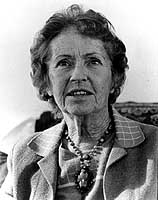Courtesy of the United States Navy
Captain Joy Bright Hancock, USN (1898-1986)
Later, Mrs. Ralph A. Ofstie
Joy Bright was born in Wildwood, New Jersey, on 4 May 1898. During World War I, after attending business school in Philadelphia, Pennsylvania, she enlisted in the Navy as a Yeoman (F), serving at Camden, New Jersey and at the Naval Air Station, Cape May. Following the war, she married Lieutenant Charles Gray Little, who was killed in the crash of the airship ZR-2 in 1921. A year later, she obtained employment with the Bureau of Aeronautics, where her duties including editing the Bureau’s “News Letter”, which later evolved into the magazine “Naval Aviation News”. In 1924, she left the Bureau to marry Lieutenant Commander Lewis Hancock, Jr., who lost his life when USS Shenandoah (ZR-1) crashed in September 1925.
Joy Bright Hancock returned to the Bureau after attending Foreign Service School and obtaining a private pilot’s license. For more than a decade before World War II and into the first year of that conflict, she was responsible for the Bureau’s public affairs activities. In October 1942, she was commissioned a Lieutenant in the new Women’s Reserve (WAVES). She initially served as WAVES representative in the Bureau of Aeronautics and later in a similar position for the Deputy Chief of Naval Operations (Air), rising to the rank of Commander by the end of the War.
In February 1946, Commander Hancock became the Assistant Director (Plans) of the Women’s Reserve and was promoted to WAVES’ Director, with the rank of Captain, in July of that year. She guided the WAVES through the difficult years of Naval contraction in the later 1940s and the expansion of the early 1950s, a period that also saw the Navy’s women achieve status as part of the Regular Navy. Captain Hancock retired from active duty in June 1953. The next year, she married Vice Admiral Ralph A. Ofstie and accompanied him on his 1955-56 tour as Commander, Sixth Fleet. Following her husband’s death in late 1956, she lived in the Washington, D.C., area and in the Virgin Islands. She died on 20 August 1986.
Courtesy of the United States Navy
Who Was Joy Bright Hancock?
Historians have paid scant attention to the role of women in the American military. Today, women are an integral part of the armed forces; in the Navy, for instance, they attend the Naval Academy at Annapolis, serve aboard ships, fly aircraft, and rise to flag rank. Yet it has not always been so. Until after World War II the U.S. Navy had considered women’s service as temporary or peripheral. When Congress passed legislation in 1948 allowing women permanent standing in the regular navy, it was largely because of the untiring efforts of one woman – Captain Joy Bright Hancock. Secretary of the Navy Robert B. Anderson later acknowledged her role: “More than any one individual,” he wrote in a letter to Captain Hancock, “you are responsible for the establishment of the WAVES as a component of the Navy. Your ideals, energy, and enthusiasm are continually reflected in the integration of women into the regular Navy.”
BACKGROUND TO A CAREER
A permanent role for women in the U.S. Navy came slowly in the twentieth century. The Navy Nurse Corps, established in 1908, provided service opportunities for the trained nurses, but the corps was small and nurses held no military rank. In fact, the corps remained a separate unit, outside the regular navy. The first real chance for women to serve came in 1917, when the United States entered World War I. During the conflict 11,275 women served as yeoman) – the “F” for female – in the U.S. Naval Reserves. Most were clerical workers; none were officers, and none had the chance to pursue a military career in the regular navy. After the war the yeomen (F) returned home and officials gave no consideration to enlisting women in the navy for many years. But one yeoman (F), Joy Bright, had enjoyed navy life and bluntly questioned the wisdom of barring American women from naval careers. Few other military personnel, men or women, were raising such issues, but this innovative attitude was typical of the New Jersey native.
Born on May 4,1898, in Wildwood, New Jersey, Joy Bright was the third of William and Priscilla Bright’s six children. Her father, a real estate and insurance agent, helped develop the resort areas of the New Jersey coast. Involved in regional and state politics and business, William Bright was, at times, tax collector, city clerk, commissioner of deeds, Cape May County sheriff, mayor of Wildwood, and director of the Marine National Bank. A state legislator for twelve years, he was president of the Senate and also lieutenant governor’s Priscilla Bright had energy to match her husband’s. She helped with business and politics and tended to home and children. A firm believer in women’s rights, she took part in the woman’s suffrage movement. Activists Carrie Chapman Catt and Jane Addams often visited the Bright home and helped inspire Joy Bright and her two sisters to seek uncommon goals. Thus her family and her youthful experiences instilled a strong self-confidence and a belief that there was no limit to women’s capabilities.
Enjoying such family support and encouragement, young Joy Bright took full advantage of the opportunities open to a child of the well to do. She attended the local public school and took part in many activities, including basketball, an unusual sport for girls in the early twentieth century…” That’s how I broke my nose, and it stayed crooked,” she later recalled.
She also displayed a mechanical aptitude, learning to repair bicycles and change car tires, to paint, and to do carpentry work! Her mechanical skills would be important in later years. She gained practical office experience by helping in her father’s real estate and insurance firm. When she was only fourteen, her father gave her a vote of confidence by leaving her in charge of the office while he attended political conventions! By the time she graduated from high school, Joy Bright had matured into a woman whose small stature belied a strong personality and an unswerving belief that women were as capable as men.
Her sisters shared and reinforced her outlook.
Eloise Bright graduated from Mt. Holyoke College and the University of Pennsylvania Law School, and then practiced law in Wildwood. In the late 1920s she became executive secretary to her father, who was then president of the New Jersey Senate; she was the first woman to hold that position.
Another sister, Honor Bright, graduated from the New Jersey Normal School and taught Woodbine. She later gained recognition in educational circles for her skillful management of upper-primary-grade children.
After high school, Joy Bright took a secretarial course at the Pierce School of Business Administration in Philadelphia, and then worked briefly as a statistician. Before her business career got underway, however, the United States entered World War 1. With that conflict, a novel opportunity for American women opened, and, always eager to try something new, Joy Bright took it.
Professional Beginnings
When the Navy permitted women to volunteer with the rank of yeoman (F) during World War I, it was young Bright’s intention to help the war effort by representing her family in the military. In I918, she joined the navy as a yeoman (F), 1st class, soon rose to chief yeoman. She was one of relatively few women to escape a clerical assignment; she served instead as a courier, at the Camden shipyard. The navy then transferred her to the Naval Air Station at Cape May. The move was an important one for Yeoman Bright’s future. Naval aviation was in its infancy during the war, and constant exposure to the new blimps and seaplanes sparked in her a lifelong fascination with naval air power. In fact, the aviation aspect of the navy was a key factor in her later decision to seek a naval career.
After the war ended, Bright continued as a civilian employee at the air station and
helped to decommission it. During this period, she met and married a naval aviator, Lieutenant Charles G. Little. The marriage, however, was brief and ended tragically. Several months after the wedding, during a test of Little’s rigid airship in England, a fierce hydrogen explosion hurled the airship into a river, killing Little and forty-five others. Stunned by the tragedy, Little’s young widow began working at the U.S. Navy’s Bureau of Aeronautics in Washington.
Organized in 1921, the bureau attracted some of the navy’s more innovative and unorthodox officers as pilots. Naval aviation was in its infancy, and these officers broke new ground for the navy as they experimented with fixed-wing and lighter-than-air aircraft, planned naval air power tactics, and sought to establish the importance of the air arm in a service dominated by “battleship” doctrines.
Joy Little thrived in this progressive atmosphere. She edited the bureau’s newsletter and set up naval aviators’ personnel files. She quickly me most of the young pilots, and their friendship would be important in later years as those pilots rose in seniority in the service. In 1923, lured by the opportunity to return both to airships and to New Jersey, she took an assignment at the Naval Air Station, Lakehurst, the headquarters for an important part of the navy’s lighter-than-air flight program. Based on the apparent success of the German zeppelins, including their military use in World War I, the navy planned a fleet of American dirigibles; and as she worked, Joy Little watched the U.S. Navy complete one of its rigid airships, Shenandoah. Lieutenant Commander Lewis Hancock arrived as part of it’s highly specialized crew, and he and Joy Little began a friendship that blossomed into romance. They were married in June 1924. Fifteen months later, however, Shenandoah broke apart and crashed during a violent storm, taking the entire crew to its death. The loss of Shenandoah was one of a series of such disasters that finally brought a halt to the U.S. Navy’s rigid-airship program in the 1930s. It was a pioneering age of flight, fraught with the dangers of all such new ventures, and once again Joy Hancock became a widow.
Physically and emotionally drained, the twenty-seven-year-old was ill for a year.
Fortunately, her family was there to help, recovering her strength she traveled around the world with her sister. The experience almost led to a career change. Visiting Hawaii, the Far East, India, Egypt, and Europe sparked an interest in the U.S. Foreign Service, an organization with career ties newly opened to women. She tried to join the diplomatic service by studying at the Crawford Foreign Service School in Washington, but the attempt ended in disappointment. She passed the written but failed the oral part of the examinations.
If the door to the Foreign Service closed, however, the lure of aviation remained. While still at the Crawford School, Hancock learned to fly. Only a few American women had won their wings by late 1920s, and Hancock’s particular circumstances made the achievement even more remarkable. Having lost two husbands and many friends in accidents, she was justifiably afraid of aircraft; so she took flying lessons and got a student pilot’s license to help conquer her fear. But, in a reflection of her earlier mechanical interests, Hancock discovered that she was more intrigued with engines than with actually flying. She learned to assemble and disassemble plane engines and realized that women could readily maintain aircraft. It was a lesson with major implications for her later career and for the careers of many other women.
Her health and self-confidence restored, Joy Hancock returned to a position in aviation. She rejoined the U.S. Navy Bureau of Aeronautics in 1930 and became a civilian head of the General Information Section. Her long familiarity with naval aviation and her more recent firsthand piloting experience added depth and knowledge to her daily contacts with the media. Again she edited the News Letter and emerged as an articulate proponent of naval air power. Hancock wrote or edited aviation articles for other magazines; she wrote her first book, Airplanes in Action, in 1938. Except for a year traveling in the Far East in the mid 1930’s, Hancock kept her job at the bureau until 1942. By this time, she was a respected figure in her field.
World War II
When World War II began, American military leaders considered what steps they might take to augment manpower. Despite the successful use of women in World War I, new calls to use women in noncombatant roles, to free men for field service, met considerable opposition. But, faced with pressing needs, the U.S. Army acted to enlist women for non-combat duty. In late 1941, Congress authorized the Women’s Auxiliary Army Corps (the WACs); but the more conservative U.S. Navy still doubted the value of women’s service. Always more progressive than the navy as a whole, however, the Bureau of Aeronautics foresaw a massive need for women if naval aviation was to function effectively. To document the case for recruiting women, the bureau determined to study how Canadians used women in their air force. At war since 1939, the Royal Canadian Air Force (RCAF), like the Royal Air Force of Great Britain, had made effective use of female personnel. Hancock, with her knowledge of naval aviation needs and her writing skills, willingly undertook the assignment. Touring Canadian air facilities, she returned to write a report lauding the accomplishments of women in the RCAF and showing how the bureau could provide jobs, housing, discipline, and administration for 20,000 American women.
Hancock’s enthusiasm was contagious, and in June 1942 the bureau pushed a reluctant Congress into authorizing the Women’s Reserve of the U.S. Naval Reserve, soon nicknamed the WAVES (Women Accepted for Volunteer Emergency Service). As in World War I, women would take over shore jobs, freeing men to fight. The naval establishment gave a collective shudder as the uncertain, and often unwelcome, experiment began. “Many admirals would prefer to enroll monkeys, dogs, or ducks,” joked one woman.
Hancock joined the U.S. Navy as a lieutenant. The highest-ranking woman at the Bureau of Aeronautics, she was the WAVES representative to the bureau and to the deputy chief of naval operations (air). She also was liaison between the bureau and Lieutenant Commander Mildred McAfee, the Women’s Reserve director. McAfee and her advisers at the Bureau of Personnel had come from the educational and professional worlds and knew nothing about the navy. They found Joy Hancock’s expertise invaluable. With her background as a yeoman (F), a navy wife, and a civilian in the Bureau of Aeronautics, she was the only WAVE leader with a clear idea of how the navy operated.
In her new position, Hancock worked for expanded and different roles for women. Her own administrative, aviation, and mechanical abilities convinced her that properly trained women could undertake almost anything. She persuaded McAfee, and then the Bureau of Aeronautics, to allow women to take specialist training at all-male aviation schools. “If men and women are to work together,” she argued, “they must train together, compete against each other in the classroom, and know that they are receiving identical training.” In a practical vein, she added that this approach would save “the Navy the expense of building separate facilities.” Hancock opened the way for coeducational training in the Bureau of Aeronautics, and the U.S. Navy’s other bureaus slowly and reluctantly adopted the idea.
One of her most important contributions was an effort to open ratings, such as aviation machinist’s mate, to women. From her own experience she knew that women could take apart and put together plane engines, but again the navy was not enthusiastic about the idea. Many pilots especially were against women servicing aircraft. But Hancock and other advocates for women had a telling argument in their favor: The war had brought thousands of American women into the nation’s civilian factories where they built the very planes the navy did not want them to service. The navy’s opposition was untenable and Hancock won her point. Eventually, about 3,000 women aviation machinist’s mates donned overalls and helped maintain the navy’s aircraft. The decision was a major breakthrough for women in the armed services.
In pressing the case for an increased role for women in the U.S. Navy, however, Hancock consistently chose to work within the established system and naval chain of command. Her methods were not confrontational; she sometimes used indirect ways to influence her male superiors. Occasionally she would simply plant an idea, watch it grow, and let the men take credit for it. Other times she would listen as an officer described the technical training requirements of ratings for men. She would then inquire if women could possibly be capable of similar training. Even a reluctant “I guess so” gave Hancock the opening she wanted. Her goal was not personal acclaim, but progress for women and thus, she believed, the welfare of the service.
The Bureau of Aeronautics sent Hancock on frequent trips to naval air stations around the country to check on adequate utilization of WAVES and on their adjustment to military life. Some of the young aviators she had known in the 1920s were now the ranking officers at many air stations, and they smoothed the way on Hancock’s inspection tours. She always made a special effort to talk with enlisted women in the barracks. These informal meetings gave Hancock firsthand knowledge of living and working conditions. She wanted no preferential treatment for WAVES. In fact, she told commanding officers to treat and discipline them as though they were men. Women needed to feel themselves as a part of the service, she believed, and receipt of equal treatment would foster mutual respect between naval personnel of both sexes.
One of her wartime trips, while official in nature, was also deeply personal. Hancock
returned to New Jersey in August 1943 to christen the U.S.S. Lewis Hancock at the Federal Shipbuilding and Dry Dock Company in Kearny. She was understandably proud that the U.S. Navy had honored her husband who had died in the airship Shenandoah. The event, however, was also an honor for her: Lieutenant Hancock was the first naval officer on active duty to christen a naval ship.
Yet Hancock continued to try to open service opportunities for other women. It was never easy, and in 1944 she turned to a particularly serious problem – sending WAVES overseas. Although the Navy Nurse Corps had sent women abroad since 1910, WAVES could only serve in the continental United States. Having successfully fought for the entry of WAVES into technical ratings, Hancock also believed that women should go where the navy needed personnel with those ratings. Conservative opposition to overseas assignments was severe; civilian and military opponents argued that the potential dangers women would face n combat areas simply would be too great and that it would be too hard to provide separate quarters and facilities to support women in forward areas. WAVES, however, stressed that women, as they had elsewhere, could free more men for front-line duty, and that many overseas assignments would not expose women to the hazards of combat or require the navy to construct new facilities. Gradually, these arguments told, and in 1944, Congress passed legislation permitting WAVES to serve in Hawaii, Alaska, and at selected Caribbean bases. Hancock played a central role in marshaling support for this measure, and she quickly became involved in its implementation. She flew to Hawaii to plan the WAVES’ arrival there (she was then a lieutenant commander, having been promoted earlier in the year), and before the war was over, more than four thousand WAVES were on duty in Hawaii, freeing additional deskbound men for combat. Hancock became a commander in March 1945, and the war ended six-month later. Her personal contributions to the war effort had been considerable. With energy and determinations, she had helped guide the WAVES’ growth to eight thousand officers and seventy-eight thousand enlisted women. Significantly, it was in great measure due to her that these women handled unusual as well as routine naval jobs. At more than nine hundred shore stations, WAVES had won admiration for their competence and had overcome a great deal of the earlier opposition to their presence in “this man’s Navy.”
WOMEN IN THE POSTWAR NAVY
Demobilization seemed to end the need for WAVES. But Hancock wanted to stay in the navy, and she knew from her inspection trips that many women shared her desire. Yet with the return to peace and an end to the wartime manpower crisis, the navy saw no need to retain women in any capacity. Even most WAVES’ leaders had considered wartime service only temporary. Hancock alone of Director McAffee’s inner circle resolved to work for a permanent place for women. The rest returned to civilian life. In February 1946, Hancock became assistant director (plans) of the Women’s Reserve and moved from the Bureau of Aeronautics to the Bureau of Personnel.
From this vantage point, Hancock planned peacetime utilization of women, while the new director, Captain Jean Palmer, handled demobilization. Both felt that women were better suited than men for the Hospital Corps, routine communications, teaching, and tasks involving manual dexterity. “There should be,” Hancock, asserted, “a regular and a reserve nucleus of trained women readily available for future emergencies.” She clearly remembered the rapid mustering out of yeomen (F) in 1919, an action which, in her view, had hurt the navy considerably. The service had to start over again with women’s service in World War II, and Hancock hoped the navy would not repeat its mistake.
Wanting and achieving permanent naval careers for women were worlds apart. Perhaps Hancock was reaching for the unattainable, but she vigorously tried to drum up support for her views. She spoke to such groups as the Army-Navy Seminar on Population and Manpower and described some vital wartime activities of the two hundred thousand military women. She then studied the various naval bureaus for possible ratings for women. Usually greeted with apathy, she finished her survey reporting on possible permanent slots for women. The study demonstrated that women could continue to serve in many vital capacities, but the times seemed against Hancock’s plans. The House Committee on Naval Affairs held hearings on a bill permitting women’s peacetime service, and several Women’s Reserve officers testified in support of the bill. But lacking the support and authority of high-ranking male officers, the bill died in committee. America was demobilizing quickly after the war, and most of the military was uninterested in the expansion or retention of programs seen as outside of the traditional organization of the armed services.
In July 1946, Hancock became director of the Women’s Reserve and was promoted to Captain. Hoping to keep about five thousand women on active duty until (or if) Congress acted, she set up requirements for retaining and reenlisting WAVES. Her course was clear: she had to get the necessary legislation through Congress, and she took the lead in building an effective lobbying effort. She left no stone unturned, and used all of the organizational skills she previously had learned. Nor did she fight alone, for her position had a number of supporters in the navy. The judge advocate general’s office coached her on congressional procedures. Then she convinced the chief of naval operations and the chief of the Bureau of Personnel – who were convinced that the smaller postwar navy could use women effectively in noncom bat roles – that men rather than women must present the case to Congress. She obtained supporting statements form the various naval bureaus and offices about the need for women. Hancock also had important women allies working for the new law. The military services had merged into the U.S. Department of Defense, so Hancock and the directors of the Women’s Army Corps, the Women Marines, and the Women, Air Force, cooperated in preparing strong arguments. Finally, she rehearsed answers to any possible congressional questions and had visual aids prepared.
During congressional hearings in July 1947, Hancock testified before the Senate Armed Services Committee. The following winter the House held hearings on the bill, and Hancock listened as ranking male naval officers testified in its favor. The House bill, however, limited women to the reserves, and so the lobbying effort for the more comprehensive Senate version was accelerated. Sympathetic military leaders – many of them persuaded by Hancock – civic and patriotic organizations, and professional women’s clubs effectively lobbied for regular status for women. Finally, Congress passed the Women’s Armed Services Integration Act, and on July 30, 1948, President Harry S. Truman signed it into law. Women could now be a permanent part of the regular or reserve service.
Hancock felt triumphant for herself and for all military women. The victory had been no mean feat: In 1946, the bill that would have brought them into the regular armed forces seemed a forlorn hope. But two years of tireless and skillful effort had borne sweet fruit. For the U.S. Navy, being able to offer women a dignified career provided a reservoir of strength, quickly available for emergencies. For women, the new law not only offered a permanent place in the military, but began a gradual process of expanding the range of professional responsibilities thy could assume. In October 1948, Hancock was among the first women officers sworn into the regular navy.
The wisdom of making women a permanent part of the military became apparent quickly. When the Korean War began in 1950, the U.S. Navy called up thousands of reservists to supplement the nucleus of WAVES in the regular navy. Speedily and efficiently, reservists and new volunteers bolstered the Navy’s shore establishment. Had a regular cadre of WAVES not existed, the build-up would have considerably slower. But there was no uncertainty about women’s roles in this war; Hancock’s policies had proved correct and effective. While Hancock was fighting her legislative battles, she also instigated reforms in WAVES’ training programs. Insisting that women line officers should receive the same training as men, she got women admitted to the General Line School at Newport, Rhode Island. Enlisted women, after basic training, attended all specialists’ schools. Under Hancock’s leadership, many long-standing sex barriers in the training and use of naval women rapidly disappeared.
Some important professional barriers remained, however, one of the – overseas
assignments- rankled naval women especially. Although the other services always had sent women to noncombatant posts, existing law kept the U.S. Navy from following their lead. Hancock had argued, with only partial success, for overseas duty for WAVES during World War II. But these overseas stations were all on United States territory’ naval women wanted the same foreign assignments available to army women.
Consequently, Hancock enlisted the aid of the U.S. Army in the person of the WAC director, Col. Mary Hallaren. In the spring of 1949, Hancock and Hallaren toured Europe. In Great Britain, Holland, West Germany, Berlin, Austria, France, and Italy, Hancock saw how WACs and foreign servicewomen worked. When she came home, she wrote a report recommending a change in the statute that restricted WAVES to the United States and its territories. There was really no defense for the traditional naval position, and Hancock amply documented the ability of the army and other nations to use female uniformed personnel in foreign postings. As a result, WAVES soon were stationed in Europe and Japan. The timing was right for the change, and Captain Hancock provided the final push.
RETIREMENT AND RETOSPECT
On July 1, 1953, Hancock retired as WAVES director and received the Legion of Merit for her years of service. Characteristically, she gave credit for her achievements to the women with whom she had worked and led: “To the WAVES I shall always owe a debt of gratitude for they, by their performance, loyalty and dedication, and their pride in the service, mad our accomplishments possible.” On the other hand, the WAVES owed a debt to Hancock, and her retirement marked the end of a distinguished active-duty career – a career that exemplified how effectively women could contribute to the armed forces.
The transition form active duty to civilian life did little to slow Hancock’s active
pace. She sold her house in Virginia and moved to St. Croix, the Virgin Islands. With typical energy, she learned to handle a tractor and a bulldozer to clear her land. But she soon longed for family and fiends and returned to Wildwood, New Jersey. She also renewed her old friendship with a much-decorated naval aviator, Vice Admiral Ralph A. Ofstie. He had been one of the young pilots she had met in the 1920s and they were married in August 1954. Ofstie’s last tour of duty as commander, Sixth Fleet, took the couple on a whirlwind assignment in Europe and the Mediterranean. After only a year, however, the admiral fell ill and returned to the United states where he died. Widowed for the third time after a brief marriage, Joy Hancock once more faced starting life anew.
For the next several years, she led a busy retirement. She studied French at the Berlitz School in Washington D.C, continued her studies in France, and spent several years traveling. Returning to Washington, she took courses in television and radio writing at the American University. Finally, in 1962, Hancock went back to New Jersey, where she returned to family duties in Wildwood. She managed the William H. Bright Real Estate and Insurance Company and helped her brother run the Wildwood Yacht Basin. She also helped manage family-owned real estate.
The return to Wildwood reinforced the long-standing tie between New Jersey and a native daughter. Both Wildwood and the state often recognized Hancock’s contributions to the navy and national defense. In 1946, Wildwood’s city government passed a resolution commending Hancock’s service in two wars and her promotion to WAVES director. The next year she was the featured speaker at the city’s annual Memorial Day beachfront services. Even more exciting to her was “Joy Bright Hancock Day,” proclaimed years later by the Wildwood Historical Society. A full day’s celebration commemorated her accomplishments, and the town temporarily renamed the street on which the old family home stood as Joy Bright Street. Her military medals and photographs were displayed at City Hall. The point here is not that a hometown chose to honor a military hero; that sort of thing was commonplace in the days after World War II. The fact that a woman would be so recognized, however, was something of a novelty. The honors accorded Hancock gave further evidence of what many social historians have concluded about the war: it was a watershed in moving the United States toward a society more open to women and minorities.
The state also honored Hancock. In 1950, Governor Alfred E. Driscoll awarded her a scroll commending her distinguished service, and the New Jersey Senate passed a resolution paying tribute to her. Earlier the state had awarded her a special medal for her World War I service. The accolades from her hometown and from her state deeply touched Hancock. Her ties with them always had been close; she never had forgotten her New Jersey background.
In 1971, Hancock moved to a U.S. Navy retirement home in McLean, Virginia, where she maintained an active interest in women in the navy until her death in 1986. She served on advisory councils and gave many speeches to military and veterans groups. While still Wildwood, the retired captain had been unhappy that little had been written about women in the navy, so she began compiling her memoirs. Completed in New Jersey, the book, Lady in the Navy, was published in 1972 after Hancock had taken up residence in Virginia. A personal account of the growth of the WAVES and of her other reminiscences, Hancock’s work is perhaps the best autobiographical study of women in the navy.
Although Captain Hancock gave herself little credit for women’s vast strides in the U.S. navy – she never regarded herself as a reformer – her contributions ere manifold. Her own work, from a yeoman (F) forward, offered the armed services a lesson in the effectiveness of placing women in uniform. When placed in a position of responsibility, she acted consistently on behalf of opportunities for and fairness toward other women – and in the cause, as she saw it, of the national defense. Readily seeing the need for women’s service, she helped the Bureau of Aeronautics prepare a strong case for legislation establishing the Women’s Reserve. As the only high-ranking woman officer with an extensive naval background, she instigated diversified roles for WAVES during eh war. She had always believed that trained women should be allowed to work to their capabilities. At the same time she wisely limited her goals sot the attainable and worked with the existing naval structure. When she became WAVES’ director, she spent two years doggedly pursuing her main goal – a permanent place for women in the U.S. Navy – and was instrumental in the passage of the Women’s Armed Services Integration Act.
Without her, women probably would have waited a much longer time before enjoying a career in the U.S. navy.
Ralph Andrew Ofstie, Vice Admiral, USN (1956) and Joy Bright Little Hancock Ofstie, Captain, USN (1986), are buried together in Section 30, Grave .2138, Arlington National Cemetery.
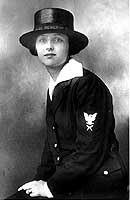
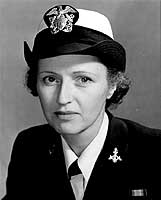
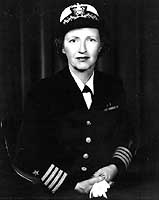
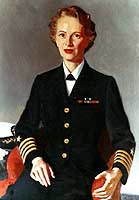
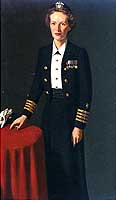
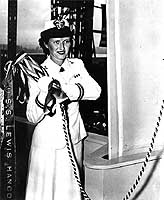
Michael Robert Patterson was born in Arlington and is the son of a former officer of the US Army. So it was no wonder that sooner or later his interests drew him to American history and especially to American military history. Many of his articles can be found on renowned portals like the New York Times, Washingtonpost or Wikipedia.
Reviewed by: Michael Howard

